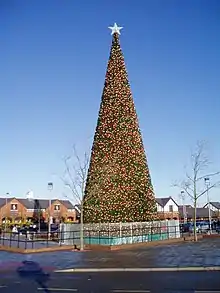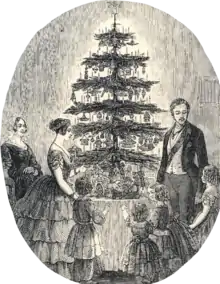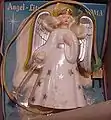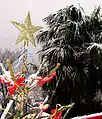Tree-topper
A tree-topper or treetopper is a decorative ornament placed on the top (or "crown") of a Christmas tree. Tree-toppers can take any form, but the most common shapes are a star (representing the Star of Bethlehem), finials, angels ("Christmas angel"), or fairies. Other tree-toppers include paper rosettes, ribbon bows, Father Christmases or Santa Clauses, Christian crosses, owls, white doves, spikes and sunbursts.

Tree-toppers may be made of blown glass, metal, or plastic, among other materials. Plastic tree-toppers are often electric and once connected with the tree's lights glow from within. Following World War II, various symbols of Christmastide, such as Santa Claus, were introduced as electrified tree-toppers.
Origin and use

Use of a Christmas angel as a tree-topper represents to some the angel Gabriel from the Nativity of Jesus:
"And in the sixth month the angel Gabriel was sent from God unto a city of Galilee, named Nazareth, to a virgin espoused to a man whose name was Joseph, of the house of David; and the virgin's name was Mary."
— Luke 1:26–27 (KJV)
Use of a star represents the Star of Bethlehem:
"Now when Jesus was born in Bethlehem of Judaea in the days of Herod the king, behold, there came wise men from the east to Jerusalem, saying, 'Where is he that is born King of the Jews? for we have seen his star in the east, and are come to worship him.'"
— Matthew 2:1–2 (KJV)
The use of the angel tree-topper goes back to the Victorian era, corresponding to the rise in popularity of Christmas trees in England. The Illustrated London News published a picture of Queen Victoria, Prince Albert, and their family around a Christmas tree topped with an angel, and by its influence the Christmas angel became the most common tree-topper.[1] Note that this fact may not be true today; YouGov put out a survey in the United States with approximately 39% of the 2,772 adults surveyed putting a star as their tree-topper, topping the 23% that put an angel instead.[2]
During the 1870s, in conjunction with the growing power of the British Empire, the Union Jack had become the most popular tree-topper.[3]
Alternatives
Some Neo-pagan homes celebrate the winter solstice, which falls close to Christmas, by decorating an evergreen tree as a symbol of continuing life,[4] but make an effort to decorate it with non-Christian symbols and often choose tree-toppers representing the sun.
Popular culture
Hans Christian Andersen's 1844 short story, "The Fir-Tree", describes the decoration of a Danish Christmas tree, including its topper:
"On one branch there hung little nets cut out of colored paper, and each net was filled with sugarplums; and among the other boughs gilded apples and walnuts were suspended, looking as though they had grown there, and little blue and white tapers were placed among the leaves. Dolls that looked for all the world like men—the Tree had never beheld such before—were seen among the foliage, and at the very top a large star of gold tinsel was fixed."[5]
The use of a tree-topper is also depicted in Christmas songs, with lines such as "Först en stjärna utav gull" and "So hang a shining star upon the highest bough".
Image gallery
 Post-War NOMA plastic, electrified angel tree-topper
Post-War NOMA plastic, electrified angel tree-topper Croatian Christmas star
Croatian Christmas star Homemade Christmas angel
Homemade Christmas angel
See also
References
- History of Christmas Trees at Christmas Archives Archived 2007-12-21 at the Wayback Machine
- "Daily Question | 12/12/2019 | YouGov". today.yougov.com. Retrieved 2020-12-23.
- History of Tree-toppers
- Christmas Tree-topper at Mahalo
- Andersen's Fairy Tales, Project Gutenberg text
External links
![]() Media related to Christmas tree at Wikimedia Commons
Media related to Christmas tree at Wikimedia Commons
